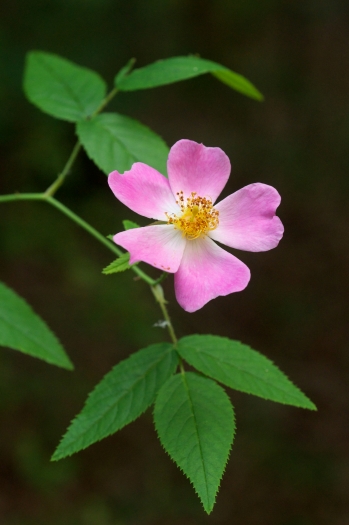Climbing Rose
(Rosa setigera var. tomentosa)
Climbing Rose (Rosa setigera var. tomentosa)
/
/

Eric Hunt
CC BY-SA 4.0
Image By:
Eric Hunt
Recorded By:
Copyright:
CC BY-SA 4.0
Copyright Notice:
Photo by: Eric Hunt | License Type: CC BY-SA 4.0 | License URL: https://creativecommons.org/licenses/by-sa/4.0 | Uploader: Eric in SF | Publisher: Wikipedia Commons | Title: Rosa_setigera.jpg |



















Estimated Native Range
Summary
Rosa setigera var. tomentosa, commonly known as Climbing Rose, is a deciduous perennial vine native to open woodlands and forest edges in Central and Eastern North America. It can grow to a height of 8-12 feet (2.4-3.7 meters) and a width of 6-10 feet (1.8-3 meters). This plant is characterized by its climbing habit, often supported by other vegetation or structures, and its prickly stems. The flowers are typically pink and bloom in early summer, with some varieties offering a second bloom period in late summer or early fall. The flowers are moderately showy and attract pollinators.
Climbing Rose is valued for its ornamental flowers and ability to cover trellises, arbors, and fences, providing vertical interest in the garden. It is relatively low maintenance once established and can be used for naturalizing areas or as a border plant. It prefers full sun but can tolerate partial shade, and while it adapts to various soil types, it thrives in well-drained loamy soils. Regular pruning is necessary to maintain its shape and promote vigorous growth. Potential problems include susceptibility to diseases such as black spot and powdery mildew, and pests like aphids and spider mites.CC BY-SA 4.0
Climbing Rose is valued for its ornamental flowers and ability to cover trellises, arbors, and fences, providing vertical interest in the garden. It is relatively low maintenance once established and can be used for naturalizing areas or as a border plant. It prefers full sun but can tolerate partial shade, and while it adapts to various soil types, it thrives in well-drained loamy soils. Regular pruning is necessary to maintain its shape and promote vigorous growth. Potential problems include susceptibility to diseases such as black spot and powdery mildew, and pests like aphids and spider mites.CC BY-SA 4.0
Plant Description
- Plant Type: Subshrub, Vine
- Height: 8-12 feet
- Width: 6-10 feet
- Growth Rate: Moderate
- Flower Color: Yellow, Pink, Red
- Flowering Season: Summer
- Leaf Retention: Deciduous
Growth Requirements
- Sun: Full Sun
- Water: Medium
- Drainage: Medium, Fast
Common Uses
Bee Garden, Bird Garden, Butterfly Garden, Fragrant, Showy Flowers
Natural Habitat
Open woodlands and forest edges
Other Names
Common Names: Illinois Rose
Scientific Names: , Rosa setigera var. tomentosa,
GBIF Accepted Name: Rosa setigera var. tomentosa Torr. & A.Gray